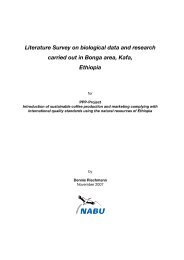Flora Biodiversity Assessment in Bonga, Boginda and Mankira Forest
Flora Biodiversity Assessment in Bonga, Boginda and Mankira Forest
Flora Biodiversity Assessment in Bonga, Boginda and Mankira Forest
Create successful ePaper yourself
Turn your PDF publications into a flip-book with our unique Google optimized e-Paper software.
Figure 1. Estimated L<strong>and</strong>cover of <strong>Bonga</strong> (<strong>in</strong>clud<strong>in</strong>g <strong>Mankira</strong>)<br />
Table 1. Extent of major l<strong>and</strong> covers <strong>in</strong> <strong>Bonga</strong> <strong>and</strong> <strong>Mankira</strong><br />
BONGA-NFPA<br />
Area <strong>in</strong> ha Percent<br />
total<br />
Dense <strong>Forest</strong> 69361.4 42.5<br />
Disturbed <strong>Forest</strong> 17961.9 11.0<br />
Highly Disturbed <strong>Forest</strong> 30675.8 18.8<br />
Bamboo <strong>Forest</strong> 5421.9 3.3<br />
Intensively Cultivated 10494.1 6.4<br />
Moderately Cultivated 28858.2 17.7<br />
Wetl<strong>and</strong> 486.6 0.3<br />
Total 163259.8 100.0<br />
Source: <strong>Flora</strong> biodiversity assessment, 2008<br />
From the above Table it is possible to conclude that more than 70 percent of the study area<br />
is covered by natural forests of different strata (dense forest, disturbed forest <strong>and</strong> highly<br />
disturbed forest). Moderately cultivated l<strong>and</strong>, where the area is stocked with trees of<br />
different density, comprises 17.7 percent. Intensively cultivated l<strong>and</strong> is characterized by<br />
less number of trees <strong>and</strong> shrubs <strong>in</strong> the area than moderately cultivated l<strong>and</strong>. This l<strong>and</strong><br />
cover comprises about 6.4 percent. Dense forest covers more than 40 percent of the total<br />
14



